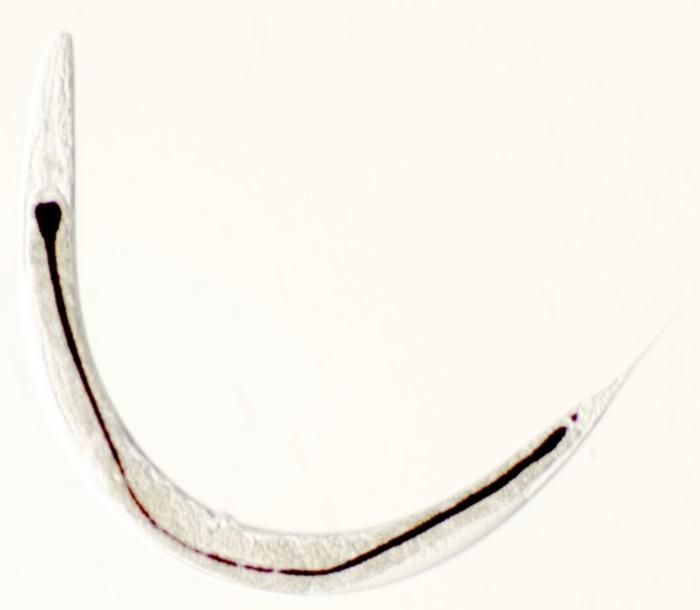Nanoparticles (NPs) are often used to reduce environmental pollution by targeting harmful chemicals in soil and water that are released by industrial and agricultural activities. These NPs are engineered to absorb, degrade, or neutralize these pollutants, providing a potential solution to environmental contamination. However, when released into the environment, they can be consumed by organisms and transferred through the food chain, resulting in widespread toxicity.

Credit: Masazumi Fujiwara from Okayama University
Nanoparticles (NPs) are often used to reduce environmental pollution by targeting harmful chemicals in soil and water that are released by industrial and agricultural activities. These NPs are engineered to absorb, degrade, or neutralize these pollutants, providing a potential solution to environmental contamination. However, when released into the environment, they can be consumed by organisms and transferred through the food chain, resulting in widespread toxicity.
To address this issue, a research team led by Research Professor Masazumi Fujiwara and Assistant Professor Yajuan Zou from Okayama University in Japan has developed a polymer coating that can be applied to NPs to prevent ecotoxicity. By altering the surface chemistry and electric charge of NPs, their binding properties can be modified. Introducing hydrophilic groups to the NP surface creates a barrier, deterring binding to biological molecules and cell surfaces.
While positively charged NPs are known to accumulate more in organisms due to their attraction to negatively charged cell surfaces, recent reports suggest that negatively charged NPs may accumulate more than their positively charged counterparts. In their study, which was published in the journal Chemosphere on May 7, 2024 and was made available online on April 20, 2024, the researchers developed a polyglycerol (PG) coating with the negatively charged group. This coating was applied to iron oxide NPs (ION) and was found to effectively reduce the accumulation of iron oxide particles in Caenorhabditis elegans, a nematode widely used as a model organism in environmental chemistry.
This research was co-authored by Prof. Fujiwara, Dr. Zou, and Dr. Yuta Nishina from Okayama University, Dr. Yutaka Shikano from Tsukuba University, and Dr. Naoki Komatsu and Dr. Eriko Kage-Nakada from Kyoto University.
“We have demonstrated that PG grafting was an effective approach to reduce the accumulation and to suppress the translocation of ION in C. elegans, which consequently alleviated the toxic outcomes such as reproductive potential and survival ratio,” says Dr. Fujiwara.
The researchers applied polyglycerol coating to ION of various sizes—20 nm, 100 nm, and 200 nm—to create ION-PG, aiming to assess the coating’s efficacy across a spectrum of NP sizes. The ION-PG were then suspended in a solution, and C. elegans nematodes were introduced. The worms were at different lifecycle stages (from larvae to adult worms), allowing the researchers to monitor NP accumulation throughout their development. A control group was exposed to a suspension containing uncoated ION. After 24 hours of exposure, the worms were collected, washed, and examined for accumulated NPs within their bodies.
The PG coating prevented NPs from sticking to biomolecules, allowing them to pass through the nematode’s intestine more freely and be excreted from their bodies. Nematodes exposed to ION-PG had lower levels of NPs in their bodies compared to the control group. The smallest NPs, which could readily traverse through the worms, were not detected.
The researchers further investigated the impact of charge groups on NP bioavailability. They introduced positively charged amino groups and negatively charged carboxyl and sulfate groups to the ION-PG and conducted the experiment again. They found that negatively charged particles passed through the worm more easily than positively charged particles due to high electrostatic repulsion against the negatively charged cell surface and low affinity to biomolecules in the nematode.
As a result, the coating mitigated the toxicity associated with ION-PG. The researchers observed improvements in both reproductive capacity and lifespan among the group exposed to the ION-PG compared to the group exposed to uncoated NPs.
The researchers underscore that the developed coating can also be applied to other NPs such as graphene oxide and titanium dioxide used for environmental remediation. “Our findings are expected to promote the design and production of large amounts of eco-friendly nanomaterials for environmental applications,” says Dr. Fujiwara.
This advancement holds promise for addressing environmental challenges and aligns with the UN Sustainable Development Goals, particularly Goal 3 (good health and well-being) and Goals 14 and 15 (conservation of water and land).
About Okayama University, Japan
As one of the leading universities in Japan, Okayama University aims to create and establish a new paradigm for the sustainable development of the world. Okayama University offers a wide range of academic fields, which become the basis of the integrated graduate schools. This not only allows us to conduct the most advanced and up-to-date research, but also provides an enriching educational experience.
About Research Professor Masazumi Fujiwara from Okayama University, Japan
Masazumi Fujiwara is a Research Professor at Okayama University, Japan, focusing on the application of quantum technology in biology, materials, and device fields. He holds a PhD in physics and leads the Nanochemistry Lab at Okayama University, where research areas include Nanometrology, Nanodiamond Quantum Sensors, Analytical Chemistry, Physical Chemistry, and Photonic Devices. Dr. Fujiwara has held various academic positions since 2004, including roles at Osaka City University, Humboldt-Universität zu Berlin, and Hokkaido University. He has served on committees of the Physical Society of Japan (JPS) and is a member of the S&T Experts Network of the National Institute of Science and Technology Policy (NISTEP).
Journal
Chemosphere
Method of Research
Experimental study
Subject of Research
Animals
Article Title
Size, polyglycerol grafting, and net surface charge of iron oxide nanoparticles determine their interaction and toxicity in Caenorhabditis elegans
Article Publication Date
20-Apr-2024
COI Statement
The authors declare that they have no known competing financial interests or personal relationships that could have appeared to influence the work reported in this paper.



